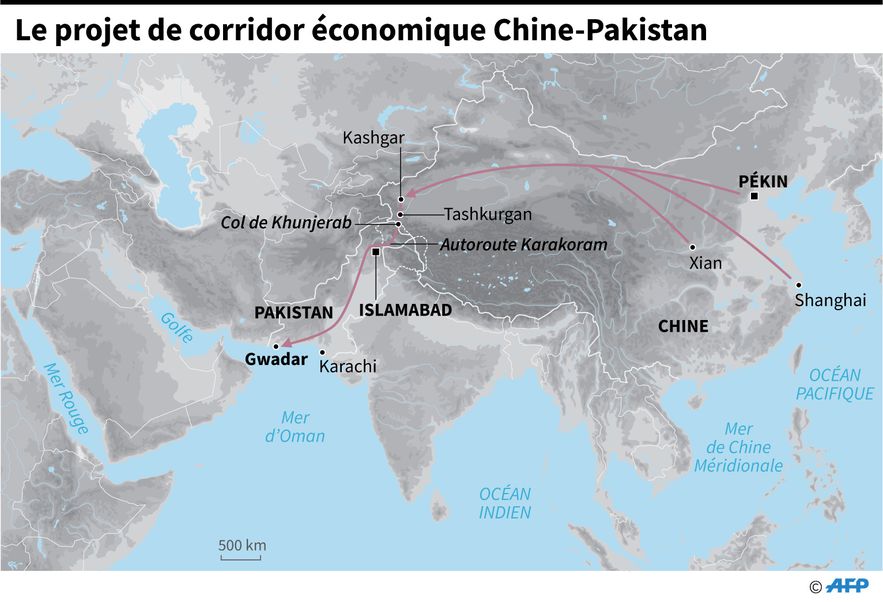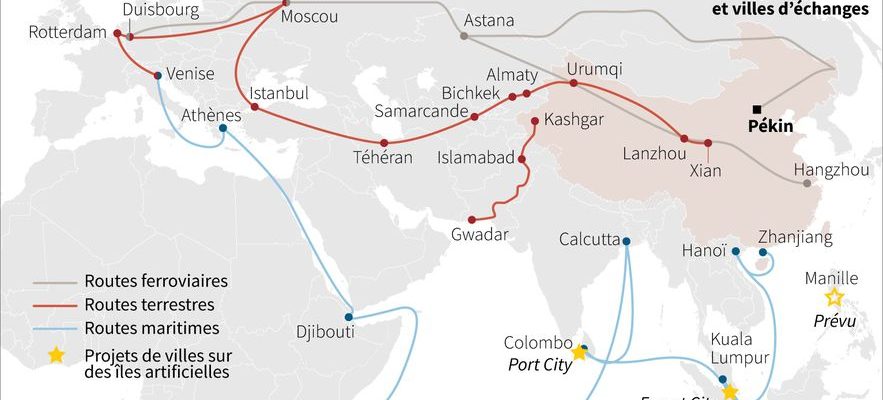Until this Wednesday, October 18, China is hosting representatives from some 130 countries for the “New Silk Roads” forum (officially called “The Belt and Road”), a major diplomatic event which should help strengthen its stature international. A leading guest at this major multilateral summit, Vladimir Putin is making his first trip to a major world power since the invasion of Ukraine in February 2022.
The New Silk Roads program, which benefits from the support of Moscow, is a gigantic project to build transport infrastructure around the world, intended to improve China’s commercial influence. Amounting to $2,000 billion, it was launched ten years ago at the instigation of Chinese President Xi Jinping. Here are five emblematic projects of this controversial program.
Laos: a railway line
A 1,035-kilometer railway connecting Laos and China was inaugurated in December 2021, a $6 billion project financed by loans from Beijing. The service, which connects the capital Vientiane to Kunming, in southern China, has already transported tens of millions of passengers according to Beijing. It is the first in a series of railway projects aimed at bringing China closer to other Southeast Asian countries.
Lao Prime Minister Sonexay Siphandone told China’s official newspaper on Sunday Global Times that this railway “benefits not only Laos, but also its neighbors”. Analysts fear serious repayment difficulties for Laos, already riddled with debt.
Map of the “New Silk Roads”, a gigantic Chinese road, rail and port infrastructure project covering 65 countries.
© / SOPHIE RAMIS, PAZ PIZARRO, LAURENCE CHU / AFP
Pakistan: an “economic corridor”
In Pakistan, several tens of billions of dollars have been allocated to the creation of a “China-Pakistan Economic Corridor” to connect western China to the port of Gwadar, in the southwest of Pakistan, near the mouth from the Gulf of Oman.
Crossing the entire country from north to south, over more than 2,000 kilometers, this corridor integrates a whole series of transport infrastructures (roads, railway lines, pipelines) and energy production, as well as the development of the port of Gwadar .
Formalized in 2013, the project offers China a direct access point to the Indian Ocean and should also ultimately facilitate the transport of hydrocarbons from the Gulf of Oman. However, it arouses suspicion in India, the corridor crossing the part of Kashmir administered by Pakistan – a territory that New Delhi considers illegally occupied. For the Mercator Institute for China Studies (Merics) in Berlin, this project is an “ambitious bet which increases the financial risks” for Pakistan, which is in the grip of economic difficulties.

Routes developed between China and Pakistan.
© / AFP
Djibouti: a naval base
Djibouti benefited from a shower of investments after accepting the construction of a Chinese military base, the first that Beijing has outside China. Inaugurated in 2017 and controlling the Gulf of Aden, at the mouth of the Red Sea, it allows Beijing to secure its enormous geopolitical and economic interests (transport, industry, energy) in the region. It neighbors French, American and Japanese naval bases in this small state in the Horn of Africa.
Faced with protests from Washington, which viewed this installation in a very negative light, Djiboutian President Ismail Omar Guelleh denounced the United States’ “fixation” on this Chinese base.

The inauguration of the Chinese base in Djibouti, August 1, 2017.
© / AFP/China OUT
Greece: a “bridgehead” in Europe
The purchase in 2016 by the Chinese Cosco of the emblematic port of Piraeus, one of the main ports in the Mediterranean basin, had the effect of a thunderclap in Europe, which suddenly fully understood the ambitions Chinese on the Old Continent. It has since become the main entry point in the Mediterranean region for Chinese products and has benefited from massive investments from Beijing.
In August, the official Chinese agency stressed that these investments had “given new life” to a port which had reached the limits of its development. Greece formally joined the New Silk Roads in 2018 with the stated ambition of becoming the bridgehead for Chinese imports in Europe.
Critics of this takeover have accused Beijing of seeking to take advantage of Greece’s weakened economic situation within the European Union and the euro zone, which China has denied.
Italy: time to withdraw?
The second shock for the European Union was the announcement in 2019 by Italy, during a state visit by Xi Jinping, that it was in turn joining the new Silk Roads, becoming the first G7 countries to sign a memorandum of understanding to this effect.
But on September 2, the Italian Minister of Foreign Affairs, Antonio Tajani, explained that the cooperation had “not produced the results” expected by the third economy in the euro zone. The agreement will be automatically renewed in March 2024, unless Italy decides to leave by the end of 2023. Italian Prime Minister Giorgia Meloni acknowledged that “the decision must still be made” whether or not to stay in This agreement.
